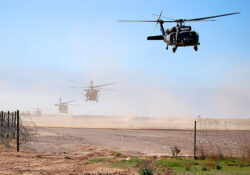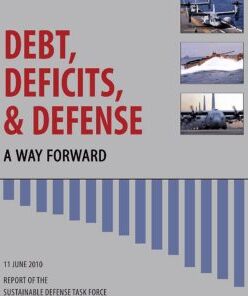Publications
Talking About Military Spending and the Pentagon Budget – Fiscal Year 2013
Four Decades of US Defense Spending
Keep Pentagon Cuts in Perspective: What the administration proposes is hardly dramatic.
Strategic Adjustment to Sustain the Force: A Survey of Current Proposals
Going for Broke: The Budgetary Consequences of Current US Defense Strategy
Pentagon Cuts in Context: No reason for “doomsday” hysteria
➪ PDF by Carl Conetta, PDA Briefing Memo #50, 11 October 2011. Analyzes the potential impact of the Budget Control Act on the defense budget under different scenarios and compares likely future budget levels to past ones. Two tables.
The Pentagon’s New Mission Set: A Sustainable Choice?
Pentagon Review Must Aim for More than Modest Cuts in Defense Spending
PDA Briefing Memo #49, 25 April 2011. ➪ read or print PDF version
The President’s proposal to trim DoD’s future budget plans by 6.5% or $400 billion over 12 years is a modest step. The forthcoming Pentagon review must aim higher in order to achieve sustainability. Two charts summarize past and planned Pentagon budgets.
Continuing Resolution: Congress Goes Easy on DoD; Rebalances Budget in Pentagon’s Favor
The struggle over a Continuing Resolution (CR) shows Congress to be reluctant to reduce defense spending. This suggests a future discretionary budget balanced more heavily in favor of the Pentagon.
The Pentagon and Deficit Reduction: FY-2012 Budget Retains Exceptional Level of Defense Spending
“Are We Ready to Cut Defense Spending? What the Polls Say.”
Pentagon Resists Deficit Reduction: Rollback in Planned Budget Falls Far Short of Deficit Reduction Goals – Puts Fiscal Reform at Risk
Experts Letter on Defense Spending to the National Commission on Fiscal Responsibility and Reform
The QDR’s Catastrophic Report
Panel: Debt, Deficits, and Defense — Report of the Sustainable Defense Task Force
Debt, Deficits, and Defense: A Way Forward
Report of the Sustainable Defense Task Force, 11 June 2010. ➪ PDF ➪ summary PDF
The Dynamics of Defense Budget Growth, 1998-2011

by Carl Conetta, May 2010. ➪ PDF
Prepared for “Economics and Security: Resourcing National Priorities,” a workshop sponsored by the William B. Ruger Chair of National Security Economics, Naval War College, Newport, Rhode Island, May 2010. This article also is a chapter in Richmond M. Lloyd, ed, Economics and Security: Resourcing National Priorities (Newport RI: Naval War College, 2010).
- A related PDA publication of interest: An Undisciplined Defense: Understanding the $2 Trillion Surge in US Defense Spending, 18 January 2010, with 21 charts & tables.
Get Serious About Reform: Budget Challenges Will Force Hard Choices
The President’s Dilemma: Debt, Deficits, and Defense Spending
An Undisciplined Defense: Understanding the $2 Trillion Surge in US Defense Spending
Assessing the 2010 QDR: essential questions
Rethink Afghanistan
Report of the Task Force on a Unified Security Budget for the United States, FY 2010
Dust-up between the NYT and the White House masks willful ignorance
Re-Envisioning Defense: An Agenda for US Policy Debate & Transition
Forceful Engagement: Rethinking the Role of Military Power in US Global Policy
The US has been using its armed forces beyond the limit of their utility. The result is not just diminishing returns, but negative ones.
Yes, We Really Must Talk With Iran
Helicopters in America’s post-9/11 wars
Carl Conetta, Project on Defense Alternatives, Sep 2008 HTML | PDF
This article is a chapter in Lutz Unterseher, Military Intervention and Common Sense: Focus on Land Forces (Berlin-Greifswald: Ryckschau, 2008.)
 Drawing on the experiences of the Afghanistan and Iraq wars, the article assesses the role played by helicopters, reviewing their strengths and limits. The author suggests that a dilemma shadows the use of these aircraft. On the one hand, they offer a unique combination of mobility, flexibility, and agility in working closely with ground forces, providing reconnaissance, fire, maneuver, and logistical support. However, helicopters prove acutely sensitive to environmental conditions, are relatively fragile, and can be countered by multiple, relatively-inexpensive weapon systems.
Drawing on the experiences of the Afghanistan and Iraq wars, the article assesses the role played by helicopters, reviewing their strengths and limits. The author suggests that a dilemma shadows the use of these aircraft. On the one hand, they offer a unique combination of mobility, flexibility, and agility in working closely with ground forces, providing reconnaissance, fire, maneuver, and logistical support. However, helicopters prove acutely sensitive to environmental conditions, are relatively fragile, and can be countered by multiple, relatively-inexpensive weapon systems.
These problems can be partially mitigated, but only in ways that substantially increase costs while narrowing the scope of the crafts’ usability. This has undercut notions of using helicopters in deep attack roles and large-scale helicopter assaults.
The article concludes by examining cost-effective roles for helicopters in combat. And it asks, Do tilt-rotor aircraft offer a viable alternative?


